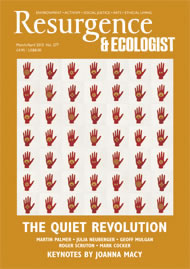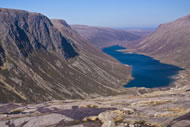Nan Shepherd’s exquisite account of her lifelong relationship with the Cairngorm mountains of Scotland was hidden away in a drawer for nearly 30 years before its publication by Aberdeen University Press in 1977. So why was a manuscript that has attracted such keen resurgent interest over the last few years kept from us for so long? In her foreword to the 1977 edition, the author explains. The original manuscript was written during the latter years of the Second World War and in its aftermath, and in that world of uncertainty she found peace in writing it. Although her trusted friend the literary correspondent Neil Gunn enjoyed it, he felt that at the time it would be hard to find anyone who would publish it. At Gunn’s instigation Shepherd tried one publisher, received a polite refusal, and that was that. It was only in her later years, whilst sorting through her possessions, that she realised “that the tale of my traffic with a mountain is as valid today as it was then. That it was a traffic of love is sufficiently clear; but love pursued with fervour is one of the roads to knowledge.”
Thanks to her own recognition, the book is still available to us another 35 years later, and its relevance to a contemporary reader is evident in the opening paragraphs of the first chapter, The Plateau. Shepherd describes her mountain story as a search for the knowledge of “its essential nature”: “To know, that is, with the knowledge that is a process of living. This is not done easily nor in an hour. It is a tale too slow for the impatience of our age, not of immediate enough import for its desperate problems. Yet it has its own rare value.”
One of the rare values of The Living Mountain, its meditation on slowness, on being rather than doing, on listening rather than generating noise, and of patiently rediscovering our vital connection with the natural world, is this: “It is, for one thing, a corrective of glib assessment: one never quite knows the mountain, nor oneself in relation to it. However often I walk on them, these hills hold astonishment for me. There is no getting accustomed to them.” So Shepherd’s journey, walking and seeking knowledge in this particular landscape throughout her life, is endless and “the whole wild enchantment”, she observes, “like a work of art is perpetually new.”
Through being rooted in her locality, her close and repeated attentiveness to it, her vision is infinitely expanded. It is not the goal, or seeking of sensation, or the acquisition of a peak that interests her, but a deepening harmony with her environment, and it is often that the mountain “gives itself most completely when I have no destination, when I reach nowhere in particular, but have gone out merely to be with the mountain as one visits a friend with no intention but to be with him.”
In her first chapter, she speaks of mountain-lovers like herself, whose bodies are better suited to the high altitudes, as touched by a little madness, like a malady for which the afflicted seek no cure.
The chapters that follow The Plateau are Shepherd’s lyrical, sensuous and philosophical account of that movement to the ‘inside’ of the mountain, highly tuned to its unpredictable elements, its recesses and lochs, the tarns and sources of its rivers, its soil and rock, plants and wildlife. All of these, she writes, are “aspects of one entity, the living mountain”. Many of the encounters she describes bring her closer to the essential nature of that entity: the white waters of its streams are “elemental transparency” like “roundness, or silence”; she listens to a waterfall, “until I no longer heard it”, and of the source of the river Dee welling from the rock for “unnumbered” years, she observes: “It does nothing, absolutely nothing, but be itself.”
This is not a sentimental union. The unpredictability of the elements can be fierce and unrelenting. She delights in the brilliance of its waters, but its force can be “appalling”; its streams both pure and “terrible”; walking through cloud or being enveloped by it can be “like the morning of creation”, or ghastly, a white “as of non-life”, and, of course, there are tragic fatalities amongst hill walkers and climbers. She experiences snow blindness and, on another venture, brushes with her own mortality, stepping out into the water of a loch and realising she is standing on the edge of a submerged precipice, one of the most defenceless moments of her life. Her first glance down into that liquid abyss frightens her, but the fear is exhilarating, “not that it ceased to be fear but fear itself, so impersonal, so keenly apprehended, enlarged rather than constricted the spirit”.
On later reflection, she knows that she would not have fallen over that precipice, as her conscious mind was only playing one small part when she waded back from the edge to safety. Her subconscious was at work. She returns to this theme in the final chapter, Being. She likens the rhythm of motion, walking hour upon hour, to a meditation with one’s senses “keyed” and the motion felt rather than known. In this rhythm, “one walks the flesh transparent… The body is not made negligible, but paramount. Flesh is not annihilated but fulfilled. One is not bodiless, but essential body.”
In her closing chapter, she refers back to her continuing search for knowledge. Whilst she has learned and been absorbed by the mountain over many years, the journey is not yet complete. She concludes with an analogy to a Buddhist’s pilgrimage into the mountain in search of God: “It is a journey into Being; for as I penetrate more deeply into the mountain’s life, I penetrate also into my own. For an hour I am beyond desire. It is not ecstasy, that leap out of the self that makes man like a god. I am not out of myself, but in myself. I am.”
We are privileged and blessed that The Living Mountain came out of that drawer. For lovers of the hills and all those who find their peace and their delight in wild things, the joyful resonance in Nan Shepherd’s voice is timeless. For modern advocates of our need to slow down, to connect with true being rather than grasping hopelessly in vain at a virtual sense of self, its republication couldn’t be more timely, or more pertinent to the “impatience of our age”.








